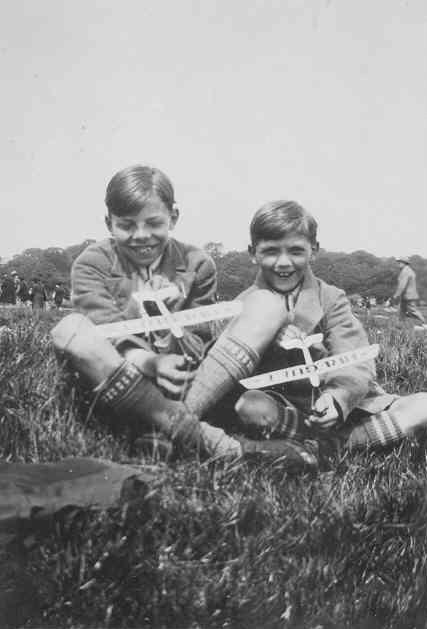
World War II Aviation Industries: Britain

Figure 1.--British boys like boys in Germany were fascinated with aviation. These British boys hold Breguet toy gliders. (Breqhuet was a Swiss watch company distribyting these gliders as an advertisement.) At the time this snapshot was taken in the 1930s, German boys were training in real gliders to be Luftwaffe pilots.
|
|
Britain since the initial American Wright Brothersl Flyers played a major role in the development of aviation. The British built some of the most effective World War I aircraft, including the Sopwith Camel, the Sopwith Triplane, the SE-5A and the Bristol Fighter. At the end of WorldcWar vI the British possessed the world's largest air force (more e than 22,000 planes) and was preparing a strategic bombing campaign against Germany. After World War I, a number of British companies were active in aviation. The British produced a series of sleek and fast seaplane racers which dominated international competitions (1920s).
The great Empire Flying Boats came into service. Aviation experts experiments with air-to-air fuelling. De Havilland produced sleek airliners like the Albatross. Researchers experimented with radar. British women fliers (Amy Johnson and Jean Batten) competed witb America's Amelia Aerheart. Britain at the time that Hitler seized power in Germany (1933) had the largest aviation indistry in Europe. This made commercial since given the far-flung Empire. The rapid NAZI rearmament program suceeded in gaining air superority only because the British failed to respond in time. In contrasr to the funds the NAZIs lavished on the Luftwaffe, a parsimonious British Air Ministry almost cancelled the Spitfire project. The Royal Air Force almost entered World War II with biplanes still in service. (The Royal Navy did enter the War with biplanes.) The British had the capacity not onlt to match the Germans, but actually to outproduce them. Only Britain's abhorence of war and desire to avoid large military expenditures enabled the NAZI to gain the advantage that nearly resulted in Britain's defeat in World War II. As late as the Munich Crisis, Prime Minister Chamberlain was concinced that he could avoid war by reasining with Hitler (1938). Once Britain began to rearm, it rapidly closed the gap and by the time of the Battle of Britain, the British aviation industry was outproducing the Germans. The Royal Air Force eaked out a narrow victory in the Battle of Britain (1940). The problem for the British was not the availability of aircraft, but the fact that they did not have an adequate number of trained pilots to fly them. The Supermarine Spitfire arrived just in time to participate in the Battle of Britain. Few of the Spitfire pilots had much experiemce when they entered combat agsinst the experience Luftwaffe pilots. The British unlike the Germans had the indistrial capacity to produce both a tactical and strategic air force. Great Britain’s Vickers, Avro, Bristol, and De Havilland began building bombers in large numbers. Hawker and Supermarine concentrated on fighters. The British produced one of the great bombrs of the war--the Avro Lancaster. Royal Air Force Bomber command played a major role in the strategic air campign against Germany. Other important British World War II aircraft included the Spitfire, Hurricane, Typhoon, Tempest, Beaufighter, Sunderland, and Mosquito. The British produced the Gloster Meteor, one of the few jet aircraft to rnter service during the War. It was not as effective as the Luftwaffe ME-262.
CIH -- - WW II

Navigate the CIH World War II Section:
[Return to World War II country aviation industry page]
[Return to Main British World War II page]
[Return to Main World War II page]
[About Us]
[Biographies]
[Campaigns]
[Children]
[Countries]
[Deciding factors]
[Diplomacy]
[Geo-political crisis]
[Economics]
[Home front]
[Intelligence]
[Resistance]
[Race]
[Refugees]
[Technology]
[Bibliographies]
[Contributions]
[FAQs]
[Images]
[Links]
[Registration]
[Tools]
[Return to the Main World War II page]
Created: 5:55 AM 11/7/2009
Last updated: 5:55 AM 11/7/2009



